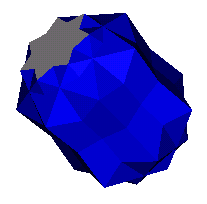
Pentakis Pentaprisms
A family of prismatic polyhedra (the naming convention is my own) which is not chiral in itself, but is the stepping stone to a second family of chiral prismatic polyhedra, the augmented snub pentaprisms.
The generation of this family, which explains their name, is as follows. Take a dodecahedron, replace ten of the pentagonal faces with the caps of pentagonal pyramids, leaving two opposing pentagons in place. The resulting model is here. This solid can be termed a pentakis pentagonally plated pentagonal anti-prism, I compact the term pentagonally plated antiprism down to a pent-a-prism. The ring of triangles is now flexible and allows the remaining pentagons to be replaced with a generic n/d-gon. Without the kis operation, only the pentagonal pentaprism (or dodecahedron) exists. The other pentaprisms are distorted, for example this square pentaprism has visibly non-planar pentagonal faces. However this pentakis square pentaprism can be generated with regular triangular faces.
Another way to generate this family of polyhedra is to start with a snub anti-prism. A ring of triangles can be inserted between the two halves of the snub anti-prism to generate a "gyro-elongated snub anti-prism" (my own naming convention again). As an example compare this snub square anti-prism with this gyro-elongated snub square anti-prism which has the inserted band highlighted in yellow. Without highlighting, it is apparent that this solid is synonymous with the pentakis square pentaprism. Either name suffices, but when the polyhedra undergo a further snub operation, I felt the name "snub gyro-elongated snub anti-prism" was clumsy and less descriptive of the solid than "pentakis snub pentaprism".
The family is 3-regular with vertices (A): n/d-3-3-3-3, (B): 3-3-3-3-3, and (C): 3-3-3-3-3-3. The (B) vertices being the apices of the pyramids. The existence of these "3^6" vertices means that the family is not convex (globally or locally) at any n/d.
Models have been generated for a
number
of values of n and n/d. Retrograde models with n/d
<
2 have also been generated.
The table
below generally has the pentagonal pyramids pointing outwards, examples
can also be generated with one or both rings of pyramids facing inwards.
Isomorphs do exist (7/3a, 7/3b) but no attempt has as yet been made to classify them.
Next: Pentakis Snub
Pentaprisms
Back: To Chiral Prisms
Back: To Index